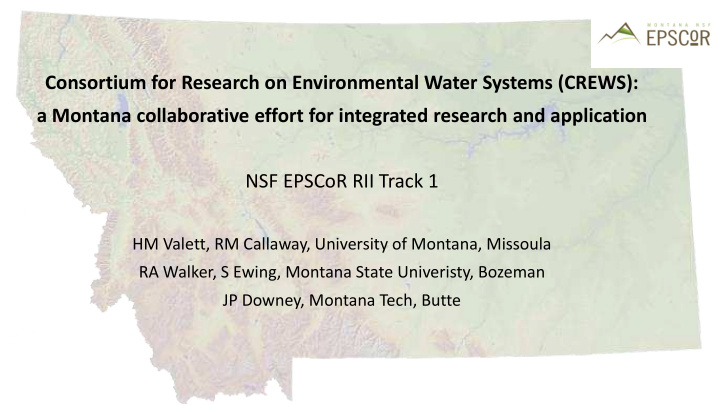



Consortium for Research on Environmental Water Systems (CREWS): a Montana collaborative effort for integrated research and application NSF EPSCoR RII Track 1 HM Valett, RM Callaway, University of Montana, Missoula RA Walker, S Ewing, Montana State Univeristy, Bozeman JP Downey, Montana Tech, Butte
From Molecules to Mainstreet: Consortium for Research * on Environmental Water Systems (CREWS) Österle and Otto 2010. ‘…activities that facilitate multilateral collaboration of researchers and practitioners during the research process.’ From Molecules to Mainstreet: (*Österle and Otto, Business and Information Systems, 2 (2010) 283-292)
MT-CREWS … research organization Molecular Environmental Systems Environmental & Engineering Ecology & Signals, Synoptics Sciences Earth Science & Sensors (MEES) (SEES) (ESSS) Natural Resource Social Science Mining: (NRSS) – Wicked Problem Upper Clark Fork River Agriculture : Judith River Watershed Energy Extraction : Interdisciplinary Powder River Basin Inquiry and Outcome C onsortium for R esearch on Disciplinary E nvironmental W ater Synthesis S ystems (CREWS)
Upper Clark Fork River (UCFR) In 1908, a massive flood contaminated the Upper Clark Fork River (UCFR) with millions of tons of mine tailings laden with heavy metals and arsenic originating from historic mining activities in the river's headwaters. Threat: mining legacy (Cu, Pb, Cd, As, Zn) now compounded by nitrogen (N) enrichment and naturally high phosphorus (P) availability, resulting in striking geographic gradients in pollutants, ecological conditions, restoration activity, and social responses Goal: Address how nutrients and metals act as subsidies and stressors in the context of river productivity, algal blooms, and ecological integrity along a contaminated river, the Upper Clark Fork River (UCFR). https://www.bigskyfishing.com/rivers/southwest-montana/clark-fork
Upper Clark Fork River … a case study (Maury Valett, lead investigator) Libby Rob Bob Metcalf Payn Hall Maury Valett UCFR lead Pre-flood Tony Mike Jerry tailwater Berthelote DeGrandpre Downey SKC downstream Janene Joe Ben Wyatt CFMR System Lichtenberg Shaw Colman Cross Flow Diagram SKC
MT-CREWS …What’s there & how much? Environmental sensors, synoptics, and signals (ESSS) Inferential State-of-the-art Watershed, software based automated DO, Solute signal stream, and Metabolic on - , and DIC, NO 3 data products data products river ecosystem hydrometabolic DOC sensors hypotheses models Specific goal: infer metabolic process from temporal variation in dissolved gas concentrations (DeGrandpre, Payn, and Bob Hall (FLBS))
MT-CREWS … Persistence? Transport? Environmental sensors, synoptics, and signals (ESSS) State-of-the-art Inferential Watershed, Hyperspectral Spatial algal airborne software based stream, and synoptic data abundance hyperspectral on pattern river ecosystem products data products cameras recognition hypotheses Specific goal: infer algal community structure and other optical properties from hyperspectral spatial variation in radiation returns. (Shaw)
Upper Clark Fork River … Impact of element availability on stream ecology? Mine Potential 1. In which size fractions are different elements? Nutrients: tailings: vectors N, P As, Cd, Cu, Fe, Mn, Al, 2. Effects on biological accumulation and trophic transfer? Pb, Zn Si, Ti 3. Primary producer influence on size distribution? Suspended Sub Dissolved: particulate micron: Metabolism <1 nm matter: 1-1000 nm >1000 nm DO and pH Day Night Day Night Primary Benthic producers Fishes macroinvertebrates (Algae, plants) Ben Wyatt Colman Cross
MT-CREWS …how does it fit into Montana’s science and societal goals? UM IRSE CAMP – Montana Tech
Acknowledgements "This material is based upon work supported in part by the National Science Foundation EPSCoR Cooperative Agreement OIA-1757351"
Recommend
More recommend